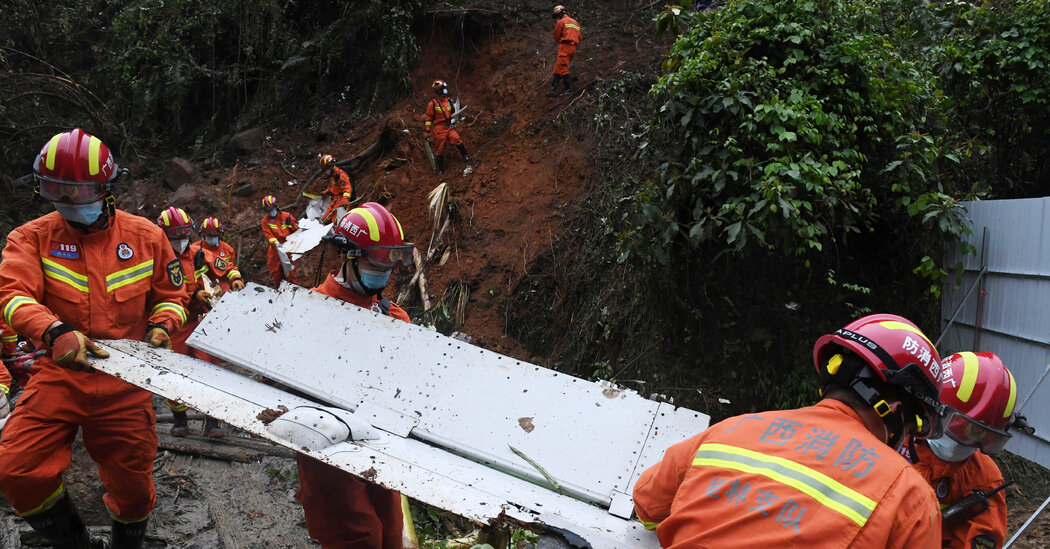Search teams have found the second of two flight recorders from a passenger plane that crashed to Earth in southern China, killing 132, officials said Sunday, nearly a week after the disaster.
Flight recorders, which collect crucial information, including the pilots’ communications and data on the aircraft’s engines and performance, could help explain why China Eastern Airlines Flight 5735 lost more than 20,000 feet in altitude in just over a minute before taking off. on a hill in the Guangxi region. The Chinese authorities confirmed on Saturday what was almost certain: that none of the people aboard the Boeing 737 had survived.
A brief bulletin from Chinese state television said the second recorder had been found, according to the search command post.
“Experts confirmed that this was the second black box,” the report said. Although they are called “black boxes”, flight recorders are usually brightly colored. The report said all other details would be released later at a press conference.
Aviation officials and experts have warned that both recorders could be severely damaged by the crash, making it more difficult to recover their data. Search crews are also trying to clear debris from the plane, which could take weeks if not longer.
In recent days, workers have been recovering parts of the plane’s engines, wings and main landing gear, along with other wreckage. Officials said they had determined the plane’s main point of impact and that most of the debris was concentrated within a 30-meter radius and a depth of about 20 meters underground. But search teams also found a four-foot-long piece of debris, likely from the plane, more than six miles from the main crash site.
The restoration of structural parts could help investigators determine how the plane broke apart using metallurgical analysis, Mike Daniel, an industry consultant and former accident investigator for the Federal Aviation Administration, said in an interview. “They need to take apart as many parts as possible to try to reconstruct the plane,” he said, although acknowledging that doing so would be “almost impossible” given the impact with which the plane hit the ground.
Search teams on Wednesday found what officials say was likely the voice recorder in the plane’s cockpit and sent it to Beijing for analysis. The other flight recorder, believed to be the one whose recovery was announced Sunday, is used to store information about the aircraft’s mechanical performance and movements.
“We cannot rule out the possibility that the storage unit was damaged,” Zhu Tao, a security officer with the Civil Aviation Administration of China, told reporters when the first recorder was found.
For days, hundreds of searchers in the isolated hills of Teng County in Guangxi seemed not to have given up on finding survivors, though the chances of finding another seemed slim. Heavy rainfall has flooded the area, increasing the risk of mudslides. Workers have used pumps to drain the soggy soil.
Live television footage from the area on Friday showed workers wearing medical masks and white personal protective suits as they scanned the steep, muddy terrain.
On Friday, several Chinese media falsely reported that searchers had found the second flight recorder. Xinhua, the official news agency, later said that was not true. Search crews had found telltale bits of orange-colored fragments that could potentially belong to the recorder, and they scanned the ground inch by inch to locate the recorder, China Television News reported.
The Chinese government considers disasters such as the crash of Flight 5735 as possible sources of public anger against officials, and has acted quickly to contain reports surrounding the crash. State media reports have emphasized expressions of concern from top Chinese leaders and the rapid mobilization of hundreds of firefighters, paramilitary forces and other workers in the search.
In past disasters, such as a high-speed train accident in 2011, survivors and relatives of victims rioted to protest the government and demand information and redress. This time, however, relatives of the people on the run have been swaddled in official security and surveillance and largely kept away from reporters.
Liu Yi† Joy Dong† Claire Fu and Li You research contributed.

